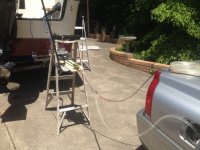capt. meares
New member
- Joined
- Jul 3, 2013
- Messages
- 146
- Reaction score
- 0
- C Dory Year
- 1988
- C Dory Model
- 22 Cruiser
- Vessel Name
- Vianey
I thought I would share a method I recently came across and have had good luck with for removing expired or near expired gas from my c-dory fuel tanks. I use my motor no less than once a month year round, so I never winterize it. I have made the mistake however of putting more fuel in my tanks than I can burn in a six month period during this slower time of the year, (Great problem to have). Using a simple fluid transfer pump from harbor and freight ($7), I just successfully transferred 10 gallons of near expired fuel from my boat fuel tank, directly to my wives Honda Pilot. Below is the pump I used.
http://www.harborfreight.com/multi-use- ... 66418.html
Yes I worked up a little sweat pumping by hand, but it is a pretty solid little pump for the money.
http://www.harborfreight.com/multi-use- ... 66418.html
Yes I worked up a little sweat pumping by hand, but it is a pretty solid little pump for the money.



